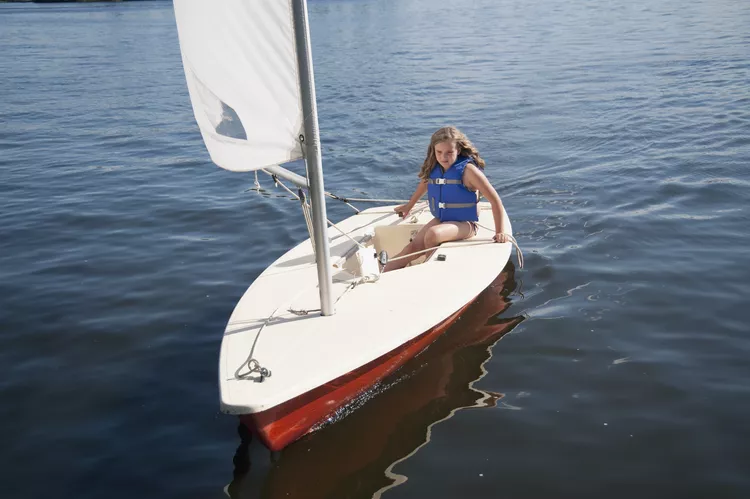Summary
- The Points of Sail
- Boat Positioning
- Wind Direction
- Getting Underway
- Turn the Sailboat
- Sailing Off a Dock or Beach
- Basics of Steering
- Steer With the Tiller
- General Sail Handling
- Navigate the Sails
- Trim the Mainsail
- Trim the Jib
- Making a Turn
- Using the Centerboard
- Slowing a Sailboat
- Stopping a Sailboat
- Putting the Boat Away
The Points of Sail

One of the most important things to remember when learning to sail is to always know where the wind is coming from in relation to the boat. The wind is blowing straight down from above in this illustration. All the arrows pointing outward from the circle are directions a sailboat can sail. For example:
- A sailboat cannot sail directly into the wind but can sail about 45 degrees toward it; this is called being close-hauled.
- When the boat is sailing across the wind, with the wind coming directly from either side (the “beam”), the boat is on a beam reach.
- When the boat is sailing at a broad angle off the wind, but not directly downwind, the boat is on a broad reach.
- When the boat is sailing directly downwind, it is said to be running.
Boat Positioning
Knowing how your boat is positioned relative to wind direction is crucial for how to set the sails and how to position your body weight. A good way to learn to pay attention to the wind is to tie short pieces of light yarn to the boat’s shrouds and keep an eye on which way they are blowing.
Wind Direction
When sailing, the motion of the boat affects wind direction. The boat’s movement through the air creates its own wind. For instance, the true wind may be blowing directly across the boat (beam reach) when the boat is at rest. However, as it gains speed, it makes its own wind by moving through the air.
This added wind from the front combines with the wind over the side to produce a resultant wind at an angle more from ahead. Thus, the boat may actually be close-hauled. For beginners, it is not necessary to focus too much on the difference between true wind and apparent wind; the apparent wind over the boat and sails is what matters most.
Getting Underway

The easiest way to learn sailing is from a mooring or a permanent anchor line in the water. The wind will blow the boat straight back, making the bow face into the wind. This is the one direction in which sailing is not possible; thus, the boat must be turned so wind is coming across from either side.
Turn the Sailboat
To turn the sailboat after it is released from the mooring line, simply push the boom out to either side. The wind will now blow against the back of the sail, rather than past it, causing the boat to rotate. This is known as “backing the sail.” Now the boat can begin to sail as you pull in the mainsheet to tighten the mainsail.
Sailing Off a Dock or Beach
Learning to sail off a dock or beach is a bit more challenging. If the boat is being blown sideways against the dock, it can be nearly impossible to get started. In this case, walk the boat to the end of the dock and turn it there to face outward into the wind. Then you can back the sail to initiate movement.
The boat cannot gain momentum if the sails are loose and flapping in the wind. As soon as they are tightened when wind is coming from the side, the boat will begin to move forward.
Basics of Steering

As soon as the sails are drawing and the boat begins to move, ensure you are sitting on the side of the boat from which the wind is coming, opposite the sails. The wind against the sails will make the boat heel or lean over, necessitating your weight on the high side to prevent capsizing.
Steer With the Tiller
Once the boat is moving, water streams past the rudder, allowing steering with the tiller. If you’ve used an outboard motor on a small boat to steer by pushing the motor’s tiller arm, you already know how to steer a small sailboat, since the tiller functions similarly.
Initially, using a tiller may seem counterintuitive; to turn the boat left (port), you move the tiller right (starboard), and vice versa.
General Sail Handling

The sheets control the sails’ positioning. Pulling the mainsheet draws the mainsail closer to the centerline of the boat, while pulling the jibsheet brings the jib closer as well.
Navigate the Sails
There’s a vital sailing principle for positioning your sails: the closer you sail to the wind (close-hauled), the more you pull in the sails; the farther off the wind (broad reach), the more you let them out.
Observe the photo showing sails far out to the side while the boat sails downwind. Notice the wind’s direction and how the boat heels more the closer it sails into the wind.
Trim the Mainsail

Adjusting the sails using the sheets is known as trimming. You trim a sail to optimize its shape for the direction you are sailing in relative to the wind.
Trim the Jib

Let out the jib sheet until its luff starts shaking or flapping, then tighten the jibsheet until it stops. As with the mainsail, the appearance of the jib doesn’t determine if it’s too tight; the best practice is to adjust until it begins to luff and then bring it back in slightly.
Making a Turn

A critical aspect of handling a sailboat is maintaining awareness of the wind’s direction. If you are not paying attention and turn incorrectly, especially in windy conditions, the boat could capsize.
Using the Centerboard

The centerboard is a long, thin blade of fiberglass or metal that hangs down in the water near the center of the boat. It is typically hinged on one end and can be raised and lowered while sailing. The photo on the left shows the top of the centerboard in the cockpit, with the board down. In the right photo, the board is visible in the water beneath the boat.
Slowing a Sailboat

For sailors, the goal is often to sail as fast as possible, whether racing or leisurely cruising. However, knowing how to slow the boat down is just as important, such as when approaching a dock, mooring, or an obstruction.
Spill Wind
Slowing a sailboat is straightforward; you simply reverse the actions used to sail fast with well-trimmed sails. The primary method to slow down is to “spill wind” from your sails by letting out the sheets until they begin to luff or even further until they flutter. This creates inefficiency, causing the boat to slow. You can tighten the sheets again to regain speed or continue to let them out until the boat coasts to a stop.
However, when sailing downwind, one cannot slow down simply by letting out the mainsail due to the boom’s alignment with the shrouds, which limits movement. Thus, pulling in the mainsheet tightly slows the boat by reducing the sail’s exposure to the wind.
Stopping a Sailboat

Ultimately, stopping the boat is necessary for docking or mooring after sailing. Unlike cars, boats do not have brakes, so it is crucial to know how to stop effectively.
Turn Toward the Wind
The common method to stop is to turn directly into the wind. This usually stops the boat within one to three boat lengths, depending on wind strength and boat speed.
- The sails will flutter loosely, ceasing to sail the boat. Practicing turning into the wind will help you understand how quickly the boat stops under varied conditions.
- Don’t forget to loosen the sheets as the boat will eventually be affected by wind direction, and if the sails catch wind again, the boat may start moving again.
In Emergencies
You can slow or stop a sailboat quickly by simply releasing the sheets. Although this may result in a loud flapping sound from the sails, the boat will slow down or stop — barring the wind pushing the mainsail, which may keep the boat moving downwind. Thus, turning into the wind remains the best way to stop.
Putting the Boat Away

After sailing and returning to your mooring or dock, remove the sails, and possibly the rudder and other gear.
- To protect the sails, they should be carefully folded before stowing them.
- Let them dry if they’re wet. If they have been exposed to saltwater, rinse them first and let them dry.
Fold a Sail
Folding a sail properly depends on its size as well as the size of the sail bag if utilized. Fewer folds mean less strain on the sail cloth.
- Spread the sail flat and fold it lengthwise multiple times, keeping the luff straight.
- When the folded width is manageable for storage, roll it into a cylinder.
- Store the sails and gear in a dry location, ready for your next sailing adventure.





